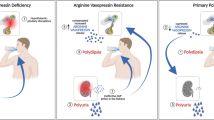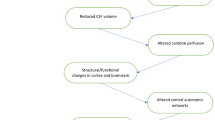Summary
In the pithed normotensive rat the intravenous administration of increasing doses of angiotensin II caused an increase in heart rate by a maximum of 93 ± 6 beats/min. This increase in heart rate was diminished dose-dependently by the concomitant infusion of the angiotensin II analogue saralasin. It was not affected by acute bilateral adrenalectomy but strongly reduced by pretreatment with reserpine. By using the selective antagonists of α1-, α2-, β1- or β2-adrenoceptors prazosin, yohimbine, atenolol and ICI 118,551, respectively, it was shown that this tachycardia was mediated by stimulation of cardiac β1-adrenoceptors. Moreover, the high endogenous angiotensin II level following pithing contributed to the basal heart rate in the pithed rat model. From our experiments it may be concluded that angiotensin II induces tachycardia in the pithed rat primarily by stimulating the sympathetic ganglia leading to the release of noradrenaline, which subsequently activates cardiac β1-adrenoceptors.
Similar content being viewed by others
References
Aitken JW, Reit E (1968) Stimulation of the cat stellate ganglion by angiotensin. J Pharmacol Exp Ther 159:107–119
Bickerton RK, Buckley JP (1961) Evidence for a central mechanism in angiotensin-induced hypertension. Proc Soc Exp Biol Med 106:834–836
Bilski A, Dorries S, Fitzgerald JD, Jessup R, Tucker H, Wale J (1980) ICI 118,551, a potent β2-adrenoceptor antagonist. Br J Pharmacol 69:292–293
Buccafusco JJ, Serra M (1985) Role of cholinergic neurons in the cardiovascular responses evoked by central injection of bradykinin or angiotensin II in conscious rats. Eur J Pharmacol 113:43–51
Capponi AM, Aguilera D, Fakunding JL, Catt KJ (1981) Angiotensin II receptors and the mechanism of action. In: Soffer RL (ed) Biochemical regulation of blood pressure. John Wiley and Sons, New York, pp 205–282
Farr WC, Grupp G (1971) Ganglionic stimulation; mechanism of the positive inotropic and chronotropic effects of angiotensin. J Pharmacol Exp Ther 177:48–55
Feldberg W, Lewis GP (1964) The action of peptides on the adrenal medulla. Release of adrenaline by bradykinin and angiotensin. J Physiol (Lond) 171:98–108
Ferrario CM, Gildenberg PL, McCubbin (1972) Cardiovascular effects of angiotensin mediated by the central nervous system. Circ Res 30:257–262
Finch L, Leach GDH (1969) The role of the sympathetic nervous system in the cardiovascular responses to angiotensin in the pithed rat. Br J Pharmacol 36:481–488
Goodfriend TL (1983) Angiotensin receptors and specific functions of angiotensin I, II, III. In: Genst J, Kuchel O, Harriet P, Cantin M (eds) Hypertension, pathophysiology and treatment. McGraw-Hill, New York, pp 271–279
Ismay MJA, Lumbers ER, Stevens AD (1979) The action of angiotensin II on the baroreflex response of the conscious ewe and the conscious fetus. J Physiol (Lond) 188:467–479
James TN (1965) Absence of direct chronotropic action of angiotensin infused into the sinus node artery. Am J Physiol 209:571–576
Jonge A de, Knape JTA, van Meel JCA, Kalkman HO, Wilffert B, Thoolen MJMC, Timmermans PBMWM, van Zwieten PA (1982) Effects of converting enzyme inhibition and angiotensin respecter blockade on the vasoconstriction mediated by α1-and α2-adrenoceptor stimulation in pithed normotensive rats. Naunyn-Schmiedeberg's Arch Pharmacol 321:309–313
Jonge A de, Thoolen MJMC, Timmermans PBMWM, van Zwicten PA (1984) Interaction of the converting enzyme inhibitors with the sympathetic nervous system. Prog Pharmacol 5:25–38
Kobayashi M, Furukawa Y, Chiba S (1978) Positive chronotropic and inotropic effects of angiotensin II in the dog heart. Eur J Pharmacol 50:17–25
Koch-Weser J (1964) Myocardial actions of angiotensin. Circ Res 14:337–344
Lee WG, Ismay MI, Lumbers ER (1980) Mechanisms by which angiotensin II affects the heart rate of the conscious sheep. Circ Res 47:286–292
Lewis GP, Reit E (1965) The action of angiotensin and bradykinin on the superior ganglion of the cat. J Physiol (Lond) 19: 538–553
Lokhandwala MF, Amelang E, Buckley JP (1978) Facilitation of cardiac sympathetic function by angiotensin II: Role of presynaptic angiotensin receptors. Eur J Pharmacol 52:405–409
Lumbers ER, McCloskey DI, Dotter EK (1979) Inhibition by angiotensin II of baroreceptor evoked activity in cardiac vagal efferent nerves. J Physiol (Lond) 294:69
Mendelsohn FAO (1985) Localisation and properties of angiotensin receptors. J Hypertension 3:307–316
Nakashima A, Angus JA, Johnston CI (1982) Chronotropic effects of angiotensin I, angiotensin II, bradykinin and vasopressin in guinea pig atria. Eur J Pharmacol 81:479–485
Nishith SD, Davis LD, Youmann WB (1962) Cardioaccelerator action of angiotensin II. Am J Physio1 202:237–240
O'Donnell SR, Wanstall JC (1979) The importance of choice of agonist in studies designed to predict β2:β1-adrenoceptor selectivity of antagonists from pA2-values on guinea pig trachea and atria. Naunyn-Schmiedeberg's Arch Pharmacol 308: 183–190
Reid JL, Millar JA, Campbell BC (1983) Enalapril and autonomic reflexes and exercise performance. J Hypertension (Suppl 1) 1:129–134
Schümann HJ, Güther W (1967) Untersuchungen zum Wirkungsmechanismus von Angiotensin am isolierten Aortenpräparat und am Blutdruck von Ratten und Meerschweinchen. NaunynSchmiedeberg's Arch Pharmakol 256:169–182
Scroop GC, Lowe RD (1969) Efferent pathways of the cardiovascular response to vertebral artery infusions of angiotensin in the dog. Clin Sci 37:605–619
Smyth HS, Sleight P, Pickering GW (1969) Reflex regulation of arterial pressure during sleep in man: a quantitative method of assessing baroreflex sensitivity. Circ Res 24:109–122
Staszewska-Barczak J, Vane JR (1967) The release of catecholamines from the adrenal medulla by peptides. Br J Pharmacol Chemother 30:655–667
Timmermans PBMWM; van Meel JCA, van Zwieten PA (1980) Evaluation of the selectivity of α-adrenoceptor blocking drugs for postsynaptic α1- and α2-adrenoceptors in a simple animal model. J Anton Pharmacol 1:53–60
Wallenstein S, Zucker CIL, Fleiss JL (1980) Some statistical methods useful in circulation research. Circ Res 47:1–9
Wasserstrum N, Herd JA (1977) Heart rate and oxygen uptake response to angiotensin in the squirrel monkey at 10°. Am J Physiol 233:H10-H14
Wilffert B (1986) Adrenoceptors in the heart. In: Van Zwieten PA, Schonbaum E (eds) Receptors in the cardiovascular system. Prog Pharmacol 6:47–64
Zimmerman BG, Gomer SK, Liao JC (1972) Action of angiotensin on vascular adrenergic nerve endings: facilitation of norepinephrine release. Fed Proc 31:1344
Zimmerman BG, Sybertz EJ, Wong PC (1984) Editorial review: Interaction between sympathetic and renin-angiotensin system. Hypertension 2:581–587
Ziogas J, Story DF, Rand MJ (1985) Effects of locally generated angiotensin II on noradrenergic transmission on guinea pig isolated atria. Eur J Pharmacol 106:11–18
Author information
Authors and Affiliations
Additional information
Send offprint requests to P. A. van Zwieten at the above address
Rights and permissions
About this article
Cite this article
Knape, J.T.A., van Zwieten, P.A. Positive chronotropic activity of angiotensin II in the pithed normotensive rat is primarily due to activation of cardiac β1-adrenoceptors. Naunyn-Schmiedeberg's Arch Pharmacol 338, 185–190 (1988). https://doi.org/10.1007/BF00174868
Received:
Accepted:
Issue Date:
DOI: https://doi.org/10.1007/BF00174868




